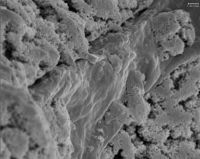
Teams
Presentation:
Bone substitution applications necessitate materials that are ideally:
Most existing bone substitutes are made from calcium phosphates ( (Hydroxyapatite, Tricalcium phosphate...). I2B studies means to improve these materials, by adding a polymeric phase (both for mechanical and biological functions). Bioactive glasses are also studied as filler in biocompatible polymers or as bone substitution scaffolds.
I2B deals with the processing of these materials, their chemical, mechanical and biological characterization (in-vitro and in-vivo tests) and the evolutions of their properties with time.
Typical articles:
M. Peroglio et al., Evaluation of a new press-fit in situ setting composite porous scaffold for cancellous bone repair: Towards a 'surgeon-friendly' bone filler?, 2010, Acta Biomaterialia 6 (9) , pp. 3808-3812
N. Ginsac et al., Crystallization processes at the surface of polylactic acid-bioactive glass composites during immersion in simulated body fluid, 2011, Journal of Biomedical Materials Research - Part B Applied Biomaterials 99 B (2) , pp. 412-419
Team: J.M. Chenal, J. Chevalier, L. Gremillard, S. Meille, S. Tadier, C. Gagnieu

Polyurethane - phospho-calcic cement composite